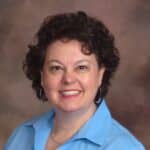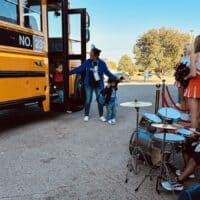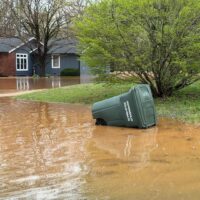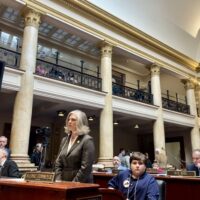A legislative committee meeting to review how the state collects and reports coronavirus data shifted quickly Thursday to Republicans’ questions about Democratic Gov. Andy Beshear’s recommendation to delay in-person schooling until Sept. 28, and his general handling of the pandemic.
“We don’t close our schools down for influenza, but we do for COVID,” said Sen. Danny Carroll of Paducah, after establishing that more children die in Kentucky from the flu (six last season) than have died from COVID-19 (one so far).
Carroll’s “why” question at the meeting of the Program Review and Investigations Committee, which he co-chairs, was answered by Doug Thoroughman, the acting state epidemiologist.
“If you don’t take the measures to reduce transmission and keep it slower, unlike flu, you are going to see eventually, like a New York — if you get the hospitals overwhelmed, you lose a lot of people, because you don’t have the ability to care for them,” Thoroughman said.
Gov. Andy Beshear regularly points out that while children generally have milder cases of the disease, they can spread it to their teachers, staff and caretakers, who are often grandparents, even if they don’t have symptoms. And those people are more likely to die from COVID-19 than from the flu.
“Mortality is definitely higher for COVID-19” than for flu, Thoroughman said. Kentucky has had 810 deaths from COVID-19, starting in March; over the past four years, 767 Kentuckians have died from the flu.
Rep. Lynn Bechler, R-Marion, asked if it is safe to say that 99 percent of the population won’t die from COVID-19. Health Commissioner Steven Stack said that’s true, but it’s important to recognize exactly how many deaths 1% would represent, noting that is 10 times greater than the fatality rate for the flu. “One percent of 330 million is 3.3 million people. So 1 percent of a big number is still a big number,” he said.
Carroll noted that almost two-thirds of the COVID-19 deaths in Kentucky have been nursing-home patients, and questioned whether that warranted delaying in-person classes or shutting down businesses.
Stack, a physician, there’s not much he’d change about what he and Beshear have done, saying the opening of schools in other states to in-person learning has shown that the virus spreads like wildfire.
“I realize we’ve got to let things get back in motion, and I think that we’re starting to do that more and more as we learn where we can pull back and allow things to go,” Stack said, “but I still think we are following the general trend where the majority of public health experts are recommending we go, as we are trying to learn as rapidly as possible.”
Schools were a persistent topic of the meeting, held three days after Beshear recommended that schools delay in-person instruction to Sept. 28. Three days before that, the Kentucky Education Association , one of his major political allies, said in-person classes shouldn’t resume until the positive-test rate declined significantly.
Carroll referred to KEA’s statement and asked Stack, “Are you aware of any political motivations to change that recommendation so quickly?” Stack replied, “No, my recommendations to the governor are based on public health.”
Asked what had changed, Stack said the state saw an exponential growth in cases, and Dr. Deborah Birx, the White House Coronavirus Task Force response coordinator, recommended that the state take aggressive steps to tamp down the infections or risk becoming the next Arizona, Texas, South Carolina or Florida.
Rep. Steve Riley, R-Glasgow, asked if there had been any consideration for the irreparable academic damage that some students will suffer, noting that there is little substitute for in-person instruction, especially in the lower grades.
Stack said it is “mission critical” to reopen schools, but suggested delaying the start of in-person instruction will allowing the state to see what happens in other states that have already reopened, and could convince some mask-reluctant Kentuckians to change their minds.
“I think there are still a fair amount of people who don’t believe in these masks,” he said. “There are still a fair amount of people who don’t believe in staying six feet apart. I think if they see all the schools shut down in Georgia and in other states that are opening and not following the rules consistently, it may help others to say ‘Maybe if I wear a mask and I stay apart that we can open schools better’.”
Sen. Whitney Westerfield, R-Crofton, asked if Stack and Beshear had considered any of the collateral damage that results from closing schools, such as substance abuse. He said it is up, but abuse referrals and behavioral-health referrals, many of which are initiated in schools, are down.
Stack concluded a long, detailed response by saying, “I think it’s fair to say that we have a pretty robust effort to try to be aware of those different trade-offs and considerations.”
Data debate
The first half of the meeting was spent on how the state gathers coronavirus data and reports it, a complicated system with dozens of testing laboratories, multiple reporting mechanisms, daily cleaning of the data and a governor who needs a daily report for his 4 p.m. news briefing.
“For COVID-19, we are compressing about two weeks of work into a few hours each day,” said Thoroughman, the epidemiologist.
One metric reported daily is the percentage of Kentuckians who tested positive for the coronavirus over the past seven days. Thoroughman said this metric isn’t perfect because some labs don’t report their negative results, despite efforts of the Department for Public Health to get them to do so.
State law doesn’t require reporting of negative tests, “so that makes it really difficult to get positivity rate,” Thoroughman said.
Carroll asked, “So why would we even report those numbers to the public when they are nowhere near accurate?”
Thoroughman replied, “Well, because there is a huge clamoring for it.” He also said the state has found a need to show more accurate figures than those reported by the federal government, which are generally 2 to 3 percentage points higher because it misses a lot of negative case numbers due to the ways different labs report. (Also, Stack has said the federal numbers include all positive tests for the same person, but the state “de-duplicates” them.)
“It sounds like we are making decisions based on that positivity rate that is totally inaccurate,” said Carroll.
Stack pushed back, saying that even though the number is not perfect, it’s an important number to pay attention to, and shows trends.
“We’re making decisions on a lot of data points and this is just one,” he said. “I can assure you our decision making is far more complicated and intricate than relying on any single metric, including this one. . . . The data has been, is and will remain imperfect, but we are committed to doing the best we can, but it is not perfect. But it is still very useful.”
On another key metric, daily new cases, which can fluctuate widely, he said, “I look at decision making often on a weekly basis, because the day to day variation may be an artifact, and not representative of what is truly happening.” He said regardless of when they are reported, all new cases are unique people.
Near the end of the three-hour meeting, Carroll’s frustration with the Beshear administration boiled over.
“The problem we have right now is half of this state doesn’t believe anything you all say, and it hinders the effort,” Carroll said. “And in my view, all of that could have been avoided from the very beginning had the governor decided to structure things properly, to reach out to the House, to the Senate, to build a consensus, to bring in a panel of experts maybe as a COVID commission, to provide advice and everyone stand up united.”
He added, “I think there would be a higher level of trust to what is coming out and at this point, honestly sir, I don’t believe a lot that comes out. There’s just so many holes in so much of it, and politics has taken over and it’s a struggle and I wish it were different, I truly wish I felt differently, but I don’t.”
Carroll asked Stack if he thought it could be done better. Stack said that theoretically it could, since most Americans say they want their politicians to work together. He also noted the strong differences of political opinion that exist in Kentucky, and said they didn’t just show up in 2020.
Carroll said, “If there ever was an incident that we need to be united on in recent decades, this is it, and we just missed it. It falls in different areas. I think we got off to a good start, I think the governor got off to a good start, it just didn’t last long. It’s just sad that this didn’t happen, and that’s why there is so much division and that’s why people are just mad right now, and it’s getting worse, and I hope that, it would be my hope, that we could get past that and we could start working together more closely.”
Other questions
Asked why the state hasn’t implemented restrictions by ZIP code or county, Stack said the virus has no regard for a map, nor do people who cross county lines for work, school, church and so on.
Sen. Karen Berg, D-Louisville, asked about the 123 child-care centers that have reported positive cases, saying that she was hearing some refuse to report them for fear of being shut down.
Stack said he had heard such stories about churches and businesses, and said there is a fine line between citizens’ need to know, to keep themselves safe, and personal or business privacy. He assured Berg that they were making every effort to protect privacy so people will participate in the process.
Sen. Michael Nemes, R-Shepherdsville, asked the average age of death and a COVID-19 death in Kentucky, and was told 75.8 and 77.4, respectively.
Asked about herd immunity, Stack said only about 5% of Kentuckians have been infected with the virus and that 60% to 70% of the population would need to be infected to reach herd immunity. Thoroughman said he thought it would need to be 95%, because the disease is so infectious. He is an epidemiologist; Stack is a former emergency-room doctor who was president of the American Medical Association .
A 95% level of infection would result in a tremendous number of deaths in a short period of time. Stack said that if somehow 100% of Kentuckians were to get infected over the next 12 months, with a mortality rate of 1%, 45,000 Kentuckians would die from it; and even if that rate were cut in half, that would leave 22,500 Kentuckians dead.
Rep. Rob Rothenburger, R-Shelbyville, asked about supplies of personal protective equipment. Stack said that he also is concerned because of the surges in other parts of the country, and “It’s about to get more difficult to get.”
Stack said the state had increased its warehouse space by 116% and wants to have a multi-month supply of PPE. He said it has about a six-week supply for hospitals and first responders in case of a major surge, more than other states in our region. He said hospitals are required to have a 14-day supply.
Stack told Bechler that cases in Kentucky appear to be on a second plateau, and avoiding another increase is important to ensure that the state has enough hospital capacity. He said the recent rise in cases in Eastern Kentucky prompted the Appalachian Regional Healthcare to imposed a two-week hold on all elective procedures in its hospitals, which are filling up with COVID-19 patients.
(Kentucky Health News is an independent news service of the Institute for Rural Journalism and Community Issues, based in the School of Journalism and Media at the University of Kentucky, with support from the Foundation for a Healthy Kentucky.)
Melissa Patrick is a reporter for Kentucky Health News, an independent news service of the Institute for Rural Journalism and Community Issues, based in the School of Journalism and Media at the University of Kentucky, with support from the Foundation for a Healthy Kentucky. She has received several competitive fellowships, including the 2016-17 Nursing and Health Care Workforce Media Fellow of the Center for Health, Media & Policy, which allowed her to focus on and write about nursing workforce issues in Kentucky; and the year-long Association of Health Care Journalists 2017-18 Regional Health Journalism Program fellowship. She is a former registered nurse and holds degrees in journalism and community leadership and development from UK.






